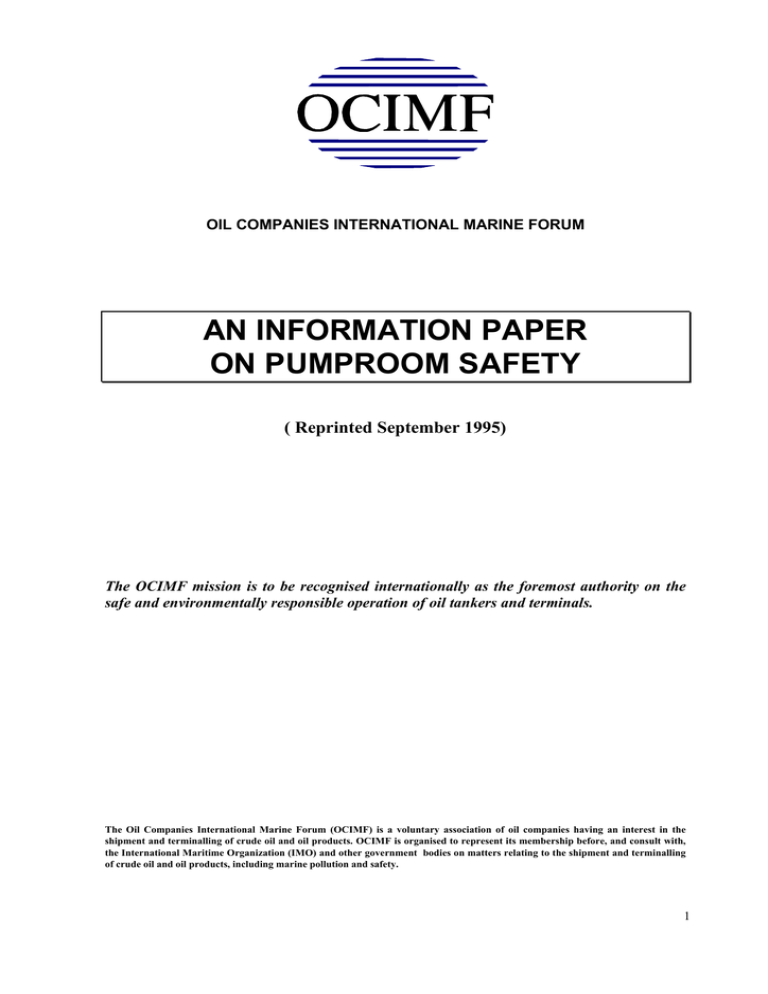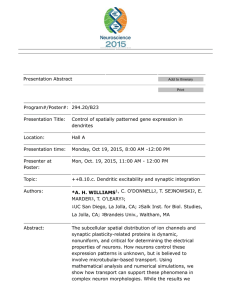an information paper on pumproom safety
advertisement

OIL COMPANIES INTERNATIONAL MARINE FORUM AN INFORMATION PAPER ON PUMPROOM SAFETY ( Reprinted September 1995) The OCIMF mission is to be recognised internationally as the foremost authority on the safe and environmentally responsible operation of oil tankers and terminals. The Oil Companies International Marine Forum (OCIMF) is a voluntary association of oil companies having an interest in the shipment and terminalling of crude oil and oil products. OCIMF is organised to represent its membership before, and consult with, the International Maritime Organization (IMO) and other government bodies on matters relating to the shipment and terminalling of crude oil and oil products, including marine pollution and safety. 1 Introduction A number of serious casualties have occurred in recent years involving fires and explosions within cargo pumprooms and have resulted in loss of lives and environmental damage. This paper has been prepared by the Oil Companies International Marine Forum (OCIMF) in order to heighten industry awareness with regard to pumproom safety issues and to propose the adoption of a package of improvement measures for general endorsement by relevant industry bodies. The International Safety Guide for Oil Tankers and Terminals (ISGOTT) recognises that cargo pumprooms, "by virtue of their location, design and operation, constitute a particular hazard and therefore necessitate special precautions.". The pumproom contains the largest concentration of cargo pipelines of any space within the ship and leakage of volatile product from any part of this system could lead to the rapid generation of a flammable atmosphere. The pumproom could also contain a number of potential ignition sources unless formal, structured maintenance, inspection and monitoring procedures are strictly adhered to. In addition, operations require the space to be routinely entered by personnel. Despite the potential hazards associated with cargo pumprooms, as far as legislative requirements are concerned, the space tends not to be given the attention warranted. SOLAS, as amended, contains requirements relating to ventilation design standards (II-2.59.3) and fixed fire-fighting arrangements (II-2.63). Classification society rules address construction standards and issues relating to machinery and fittings such as pumping and pump shafting arrangements, ventilation systems and materials and permissible electrical systems for, for example, lighting. It is the view of the OCIMF membership that the experience of the past few years indicates that more stringent requirements are necessary. This paper details a number of specific measures which, if adopted, will considerably improve the safety of oil tanker operations. For clarity, recommendations have been split into three generic groupings, namely, those that relate to procedures and practices, and are therefore applicable to all ships; those that address equipment and fittings on existing ships and, lastly, those that address equipment and fittings for new ships. Means of encouraging or ensuring implementation of the various improvement measures have not been specifically identified. However, the paper is intended to increase awareness and promote the various involved parties, such as IMO, Classification Societies and industry associations, to consider amending existing requirements. The paper has been restricted to identifying measures aimed at preventing incidents involving fires and explosions in cargo pumprooms. The adequacy of existing fire-fighting arrangements has not been examined in detail. However, it is known that fixed gas smothering systems have proven to be successful in a number of incidents. Experience with other permitted fixed systems indicates that their efficacy should be critically examined, possibly with a view to providing additional coverage/ discharge nozzles in high risk areas. Despite the good industry experience with gas smothering systems, problems have been experienced on a number of occasions with re-ignition after the initial pumproom fire has been extinguished. Consideration should therefore be given to the need to provide a back-up system, such as high expansion foam or water drenching, to supplement the existing system. On ships fitted with an inert gas system, the provision of an emergency facility to enable inertion of the pumproom could be an option, but particular attention will need to be paid to the safety and integrity of the arrangement. 2 1. Recommendations Relating to Procedures and Practices a) Entry Procedures It is strongly recommended that a formalised permit system is employed to control pumproom entry, regardless of whether or not a fixed gas detection system is in use, and that clear procedures are established with regard to undertaking pre-entry checks. In addition to detailing pre-entry checks, procedures should advocate the use of personnel gas monitors for those entering the space. Arrangements should be established to enable effective communication to be maintained at all times between personnel within the pumproom and those outside. Regular communication checks should be made at pre-agreed intervals and failure to respond should be cause to raise the alarm. A communications system should provide links between the pumproom and the navigation bridge, engine room and cargo control room. In addition, audible and visual repeaters for essential alarm systems, such as the general alarm, should be provided within the pumproom. The frequency of pumproom entry for routine inspection purposes during cargo operations should be critically reviewed with a view to minimising personnel exposure. b) Maintenance of Electrical Equipment Industry studies have indicated that the integrity of the protection afforded by the design of electrical equipment is often compromised owing to incorrect maintenance procedures and that the necessary skills and training required are often lacking. It is recommended that training in the inspection, maintenance and repair of pumproom electrical equipment, especially pumproom lighting systems, is included within the syllabus of the appropriate Certificate of Competency or, alternatively, be required by engineers when applying for dangerous cargo endorsements for their Certificates. In order to assist with routine servicing and repair, ships should be provided with detailed maintenance manuals for the specific systems and arrangements as fitted on board. c) Inspection and Maintenance of Ventilation Fans Pumproom ventilation fans are required to operate by drawing air out of the space. As a consequence, should gas be present in the pumproom the vapours will be drawn through the blades of the fan impeller and could be ignited if, for example, the blades contacted the casing or if the fan's bearings or seals over-heated. It is recommended that pumproom extractor fans, including impellers, shafts and gas seals, be visually inspected on a regular basis. At the same time, the condition of the fan trunking should be inspected and the proper operation of change-over flaps and fire dampers confirmed. Routine vibration monitoring and analysis should be considered as a means for providing early detection of component wear. d) Cargo Draining Procedures On some existing tankers, no provision is made for effective line draining and, in order to meet the demands of certain product trades, final line contents are drained to the pumproom bilge. This is an unsafe practice and it is recommended that cargo procedures are reviewed with the aim of preventing any amount of volatile product being drained to the bilge. 3 e) Routine Maintenance and Housekeeping Issues. It is important that the integrity of pipelines and pumps is maintained and any leaks are detected and rectified in a timely fashion. Pipelines should be visually examined and subjected to routine pressure tests to verify their condition. Other means of non destructive testing or examination, such as ultra-sonic wall thickness measurement, may be considered appropriate, but should always be supplemented by visual examination. Procedures should be established to verify that the integrity of mud boxes and filters is checked and ensured after they have been opened up for routine cleaning or examination. Routine inspection should also include monitoring the integrity of any bulkhead penetrations to ensure the effectiveness of gas seal arrangements. The security of critical bolts on the cargo pumps and associated fittings, such as pedestal fixing bolts, pump casing bolts and bolts securing shaft guards, should be ensured. In addition, requirements for their examination should be included in routine maintenance procedures. Diagnostic techniques, such as those utilising vibration monitoring and analysis, should be considered as an effective means to monitor the performance and condition of rotating elements, such as those associated with cargo pumps and ventilation fans. 2. Recommendations for Equipment and Fittings - Existing Ships a) Gas Detection As a first, and very necessary, line of defence, it is recommended that pumprooms on existing ships be fitted with a fixed gas detection system capable of continuously monitoring for the presence of hydrocarbon gas. Sensor location should be carefully established dependant on the particular potential sources of release within the pumproom. Due regard should be given to possible leakages of oil from any flanges that are subjected to high pressures, for example, eductor drive lines or crude oil wash (COW) mains. The gas detection system should be provided with a pre-alarm function, which, for example, could be set to alarm at a gas concentration of about 10% LEL, and a primary alarm, set to activate at gas concentrations of, say, 30% LEL. Set procedures should be established with regard to actions to be taken in the event of an alarm occurring, especially relating to vacating the pumproom or stopping cargo pumps. In view of the speed with which gas concentrations can build up in the event of leakage, consideration should be given to arranging the primary alarm so that it automatically activates cargo pump trips. Procedures should be established to ensure the gas detection system is regularly calibrated. b) Oxygen Detection Means should be provided to enable the oxygen content within the pumproom to be monitored from the deck by portable meter prior to pumproom entry. Any arrangement utilised should ensure the effective monitoring of the remoter parts of the pumproom. c) Cargo Pump Temperature Monitoring It is recommended that temperature monitoring devices are fitted to main cargo pumps in order to provide remote indication of the temperature of pump casings, bearings and bulkhead seals. The installation should include the facility for both pre- and primary alarms. Consideration should be given to the desirability of linking the alarms to a pump shut-down function. d) Bilge Alarms Bilges in all cargo pumprooms should be provided with a high level alarm which activates audible and visual alarms in the cargo control room, engine room and, possibly, on the navigating bridge. e) Local Trips for Cargo Pumps Manually activated trips for the main cargo pumps should be provided at the lower pumproom level. f) Cargo Pump Leakage Control and Detection 4 It is recommended that spray arresters be provided around the glands of all rotary cargo pumps in order to reduce the formation of oil mists in the event of minor leakage from the gland. In addition, consideration should be given to examining the feasibility of retro-fitting a double seal arrangement to contain any leakage from the primary seal and to activate a remote alarm to indicate that leakage has occurred. However, the impact of any proposed retro-fit on the integrity of the pump will need to be clearly assessed in conjunction with the pump manufacturers. 3. Recommendations for Equipment and Fittings - New Ships Although the provision of deep well pump systems may serve to "design out" the pumproom on certain tankers, for the majority, the conventional pumproom system will probably continue to offer the most effective means of handling cargo. This being the case, the following recommendations have been developed for application to new ships. a) Gas Detection New ships should be provided with a fixed gas monitoring and detection system capable of continuously monitoring, as a minimum, the oxygen and hydrocarbon content of the atmosphere within the pumproom. The system should be provided with sample points located strategically both below the floor plates and above them. Smoke dispersion tests should be undertaken during commissioning of all installations to ensure the optimum placing of sensors. Sample points should also be located within the exhaust fan trunking. The system should be provided with alarm functions which, in the case of hydrocarbon detection, could be linked to an automatic pump shut down function. b) Temperature Monitoring All cargo pump glands or seals, bearings and casings should be provided with a temperature monitoring system with remote read-outs, alarm and shut-down functions. Consideration should also be given to monitoring the temperature of the bulkhead seals of pumproom ventilation fan drive shafts. c) Vibration Monitoring It is recommended that fixed vibration monitoring equipment is provided on all centrifugal cargo pumps. The equipment should include a remote alarm facility. Consideration should also be given to monitoring other rotating elements within the pumproom, such as ventilation fans. d) Cargo Pump Leakage Detection All centrifugal cargo pumps should be equipped with a double seal arrangement designed to contain any leakage from the shaft seal and to provide remote alarm indication of its occurrence. e) Bilge Alarms All pumprooms should be provided with bilge level monitoring devices together with appropriately-located alarms. f) Cargo System Draining Arrangements Cargo systems shall be provided with a comprehensive stripping arrangement to enable all lines and pumps to be effectively drained to a cargo tank, slop tank or dedicated reception tank for subsequent discharge ashore. 4. Issues for Future Consideration OCIMF members considered the following issues associated with pumproom safety that were raised to promote discussion but on which no definitive conclusions were reached : a) Pumproom Lighting Industry experience indicates that the integrity of explosion proof pumproom lighting systems has been compromised in a number of instances by incorrect maintenance practices rendering the design safeguards ineffective. While the need for improved training is recognised, consideration should be given to reviewing the method of lighting pumprooms with a view to minimising, and eventually eliminating, the use of explosion-proof lighting systems. 5 b) Emergency Escape Arrangements In a number of pumproom incidents, personnel have been killed by the force of the explosion as they have attempted to make an escape from the space. Consideration should be given to providing a protected escape trunk accessible from the main working levels of the pumproom. The trunkway should be built and stiffened to a strength equivalent to that of adjoining bulkheads. The ladder inside should consist of a series of short lengths rising to a number of regularly placed platforms. The trunkway should be provided with ventilation and lighting and the top exit should be outside the pumproom deck housing. c) Remote Monitoring Even on new ships that are provided with the monitoring and control equipment recommended in 3 above, it will be necessary for personnel to undertake routine inspections of the pumproom while cargo is being worked. In order to minimise pumproom entry, further consideration needs to be given to the possible benefits to be obtained by installing a comprehensive remote surveillance system. 6 Issued by the Oil Companies International Marine Forum OIL COMPANIES INTERNATIONAL MARINE FORUM 27 QUEEN ANNE’S GATE LONDON SW1H 9BU ENGLAND TELEPHONE: 0171-654 1200 FAX: 0171-654 1205 REGISTERED OFFICE: CLARENDON HOUSE CHURCH STREET HAMILTON 5-33 BERMUDA Notice of Terms of use: While the advice given in this document (“ document” ) has been developed using the best information currently available, it is intended purely as guidance to be used at the user’s own risk. No responsibility is accepted by the Oil Companies International Marine Forum (OCIMF), the membership of OCIMF, or by any person, firm, corporation or organisation [who or which has been in any way concerned with the furnishing of information or data, the compilation or any translation, publishing, supply or sale of the document] for the accuracy of any information or advice given in the document or any omission from the document or for any consequence whatsoever resulting directly or indirectly from compliance with or adoption of guidance contained in the document even if caused by a failure to exercise reasonable care. 7




